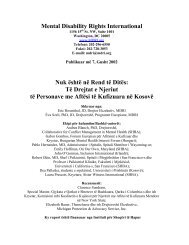Torture not Treatment - Disability Rights International
Torture not Treatment - Disability Rights International
Torture not Treatment - Disability Rights International
Create successful ePaper yourself
Turn your PDF publications into a flip-book with our unique Google optimized e-Paper software.
TORTURE NOT TREATMENT<br />
Following the release of the NYSED report on JRC in 2006, the New York Psychological<br />
Association Task Force found that<br />
―some of the techniques described as „aversive behavioral interventions‟ <strong>not</strong> only<br />
constitute corporal punishment, but are included in literature on torture<br />
techniques… 47<br />
While the infliction of pain may stop a person from engaging in a specific behavior while being<br />
subject to a course of aversive treatment, aversive treatment can<strong>not</strong> treat an underlying emotional<br />
disorder or intellectual disability. A review of the research found that ―the implementation of<br />
punishment-based procedures, including those that incorporate noxious stimulation, do <strong>not</strong><br />
guarantee long-term reductive effects in the treatment of severe disorders.‖ 48 The alleviation of<br />
symptoms only takes place while aversives are in place, leaving a person subject to this painful<br />
treatment over a long period of time. This is why JRC has had to create increasingly strong<br />
systems for administering pain and shock. JRC‘s website candidly acknowledges that aversives<br />
only bring about the temporary alleviation of symptoms:<br />
Expecting an aversive consequence to keep having its effect long after we have stopped<br />
using it is to criticize aversives for something that we have no right to expect them to<br />
do. 49<br />
One study examined a sample of five adults with developmental disabilities who had been<br />
subjected to an aversive program of electric shock, mechanical restraints, and food deprivation.<br />
This study found that the same individuals could be served in the community over two years,<br />
with the same alleviation of symptoms, using only positive behavioral supports.<br />
The results are encouraging in demonstrating that punishment-based approaches can<br />
be terminated, alternative strategies can be substituted, and through a clinically<br />
responsive system of monitoring and decision-making, behavioral adjustment can be<br />
supported without having to resort to invasive forms of treatments. 50<br />
MDRI has interviewed providers who serve individuals once detained at JRC, and their<br />
experience is consistent with the findings of this research. Contrary to the <strong>not</strong>ion that only JRC<br />
can serve the most disabled individuals, other programs are able to serve the same people<br />
without aversives:<br />
I was touring JRC and saw a little boy, maybe 6 or 8 years old, laying on the floor and<br />
shackled and handcuffed behind his back. We do <strong>not</strong> use mechanical restraints here<br />
ever! When people are given what they need, they don‟t act out. – MDRI interview with<br />
director of group homes for people with developmental disabilities serving former JRC<br />
residents 51<br />
11




